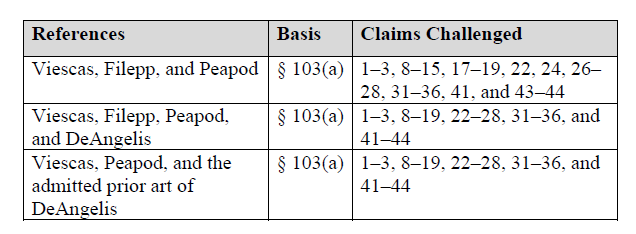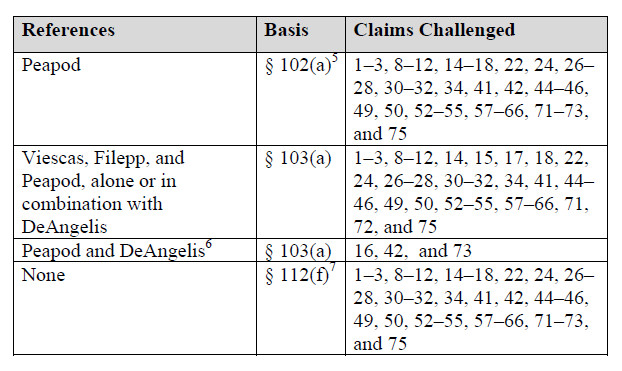CBM Petitions – Second Chances Can Be Tough
| June 17, 2015
Travelocity.com L.P., Priceline.com Inc., and Expedia, Inc. v. Cronos Technologies, LLC (Case CBM2015-00047)
June 15, 2015
Before: Jennifer S. Bisk, James B. Arpin, and Lynne E. Pettigrew, Administrative Patent Judges. Opinion by Arpin.
Summary
The Patent Trial & Appeal Board (“PTAB”) decided not to institute a covered business method patent review (“CBM”) of any challenged claim of U.S. Pat. No. 5,664,110 (“the ‘110 patent”). Travelocity, Priceline, and Expedia’s (“Petitioner”) joint request was denied because the Petition included “substantially similar arguments presented and the same references applied” in CBM2014-00082, an earlier Petition filed by Petitioner that was denied by the PTAB.
The PTAB expressly cautioned against taking a “second bite at the apple” and remarked that “a decision on a petition for covered business method review is not simply part of a feedback loop by which a petitioner may perfect its challenges through subsequent filings.”
Details
Petitioner requested institution of a CBM of claims 1-3, 8-12, 14-18, 22, 24, 26-28, 30-32, 34, 41, 42, 44-46, 49, 50, 52-55, 57-66, 71-73, and 75 of the ‘110 patent. The ‘110 patent was the subject of an earlier Petition for CBM that was denied by the PTAB. The ‘110 patent has been asserted against Petitioner in separate actions in the District Court of Delaware.
The PTAB acknowledged that at least challenged claim 22 of the ‘110 patent is eligible for review under AIA § 18 (the requirement is met if Petitioner shows it has been sued or at least charged with infringement of a covered business method patent, which the PTAB broadly interprets as relating to money matters, not necessarily the financial industry). However, the PTAB declined review after considering the papers in the present Petition, as well as the papers filed in the earlier Petition.
The AIA provides the PTAB with discretion to decline to institute CBM. See 35 U.S.C. § 324(a). In support of its ultimate denial of the Petition, the PTAB cites to the following portion of 35 U.S.C. § 325(d) (emphasis added):
“In determining whether to institute or order a proceeding under this chapter, chapter 30, or chapter 31, the Director may take into account whether, and reject the petition or request because, the same or substantially the same prior art or arguments previously were presented to the Office.”
The PTAB noted that the claim construction standard changed from “broadest reasonable interpretation” to the Phillips standard (words of a claim “are generally given their ordinary and customary meaning” as understood by a person of ordinary skill in the art at the time of the invention) from the earlier Petition to the present Petition because the ‘110 patent expired in the interim period. However, the PTAB brushed aside Petitioners argument that the new claim constructions alter the legal argument, stating: “Here, because we reject the Petition without reaching the merits of Petitioner’s grounds for unpatentability regarding the challenged claims, it is not necessary for us to construe any term of the challenged claims.” Page 6.
The PTAB then considered the papers filed in the earlier Petition and the present Petition, summarized below in the following charts.
CBM2014-00082 (earlier Petition).
CBM2015-00047 (present Petition).
The PTAB recognized that the present Petition includes alleged challenges based on additional claims and grounds, namely that Peapod anticipates the challenged claims and that the term “communication means” is indefinite under 35 U.S.C. § 112. The PTAB nevertheless rejected the present Petition because “the same or substantially the same prior art or arguments previously were presented to the Office” in the earlier Petition. The PTAB emphasized the coordinating conjunction – “or” – and stated that it had discretion to decline to institute the CBM solely on the basis of Petitioners acknowledgement that “the same references are applied in the earlier and present Petitions.” Page 10. The PTAB went further and stated that their decision to decline institution is also based on fact that Petitioner asserts the same or substantially the same arguments in the present Petition that were asserted in the earlier Petition. The PTAB remarked:
- “[A]lthough the Petitioner asserts that Peapod anticipates the challenged claims in the present Petition, Petitioner asserted that each of Viescas, Filepp, and Peapod ‘individually may render the claims unpatentable’ in the earlier Petition.” Pages 10-11.
- “[I]n the present Petition, Petitioner simply recasts the facts in the context of the same legal arguments.” Page 11.
- Regarding additional claims – “[A]s with the claims challenged in the earlier Petition, Petitioner asserts substantially the same arguments based upon the same references against all of the challenged.” Page 12.
- Regarding 112 argument – “[T]he indefiniteness ground directed to claims […] in the present Petition amounts to a second bite at the apple for Petitioner, and Petitioner seeks to step back from the construction of the term ‘communication means’ that it adopted in the earlier Petition. We are not persuaded that allowing Petitioner to begin a second proceeding now to argue a claim deficiency of which it was aware, but did not assert in the earlier Petition, is an appropriate circumstance in which to grant covered business method patent review.” Pages 12 and 13 (emphasis added).
The PTAB stated that “[r]equiring Patent Owner to respond to multiple assertions of substantially the same arguments based on the same references is inconsistent with such a just, speedy, and inexpensive resolution.” 37 C.F.R. § 42.1(b). The PTAB also warned that “a decision on a petition for covered business method review is not simply part of a feedback loop by which a petitioner may perfect its challenges through a subsequent filing.
The PTAB exercised it discretion under 35 U.S.C. § 325(d) to reject the Petition because the same references and substantially the same arguments were previously presented to the Board.
Take Away
- The AIA mandates that Inter Partes Review (“IPR”) petitions be filed within one year of when the petitioner was first accused of infringement; however, no such mandate exists for CBM petitions. Therefore, this is a big win for owners of covered business method patents because it raises the bar for a petitioner to successfully persuade the PTAB to institute a CBM based on a second Petition.
- Patent owners facing a second CBM petition for the same patent should stress in their Patent Owner’s Statement (filed within 3 months of the Petition), if applicable, that “the same or substantially the same prior art were presented to the Office” and/or “the same or substantially the same arguments were presented to the Office.” This argument would be more persuasive if based on Petitioner’s own words submitted in the original Petition, such as in this case where the Petitioner originally argued that the claims were obvious, yet asserted that each of the references ‘individually may render the claims unpatentable’ in the earlier Petition.” These words came back to haunt Petitioner in their second Petition, where they attempted to argue that their anticipation grounds based on one of these references was a new grounds of rejection. Indeed, these words came back to haunt the Petitioner.
- Much like IPRs, Petitioners are advised not to leave any arguments on the table in their original Petition for CBM. The PTAB cautioned regarding using second Petitions as “a second bite at the apple.” Accordingly, Petitioners are advised to carefully draft the arguments in their original Petition so that the patent owner in response to any second Petition cannot latch onto their original language (g., such as “individually render the claims unpatentable” and “communication means” arguments) to persuade the PTAB that the new grounds is substantially the same as the previous grounds.
- Decisions on whether to institute a trial (including decisions not to institute a trial and decisions to institute a trial based on one or some of the grounds of unpatentability asserted in the petition) are final and nonappealable to the Federal courts, a party may request a rehearing before the Board (§§ 42.71(c) and (d)).




